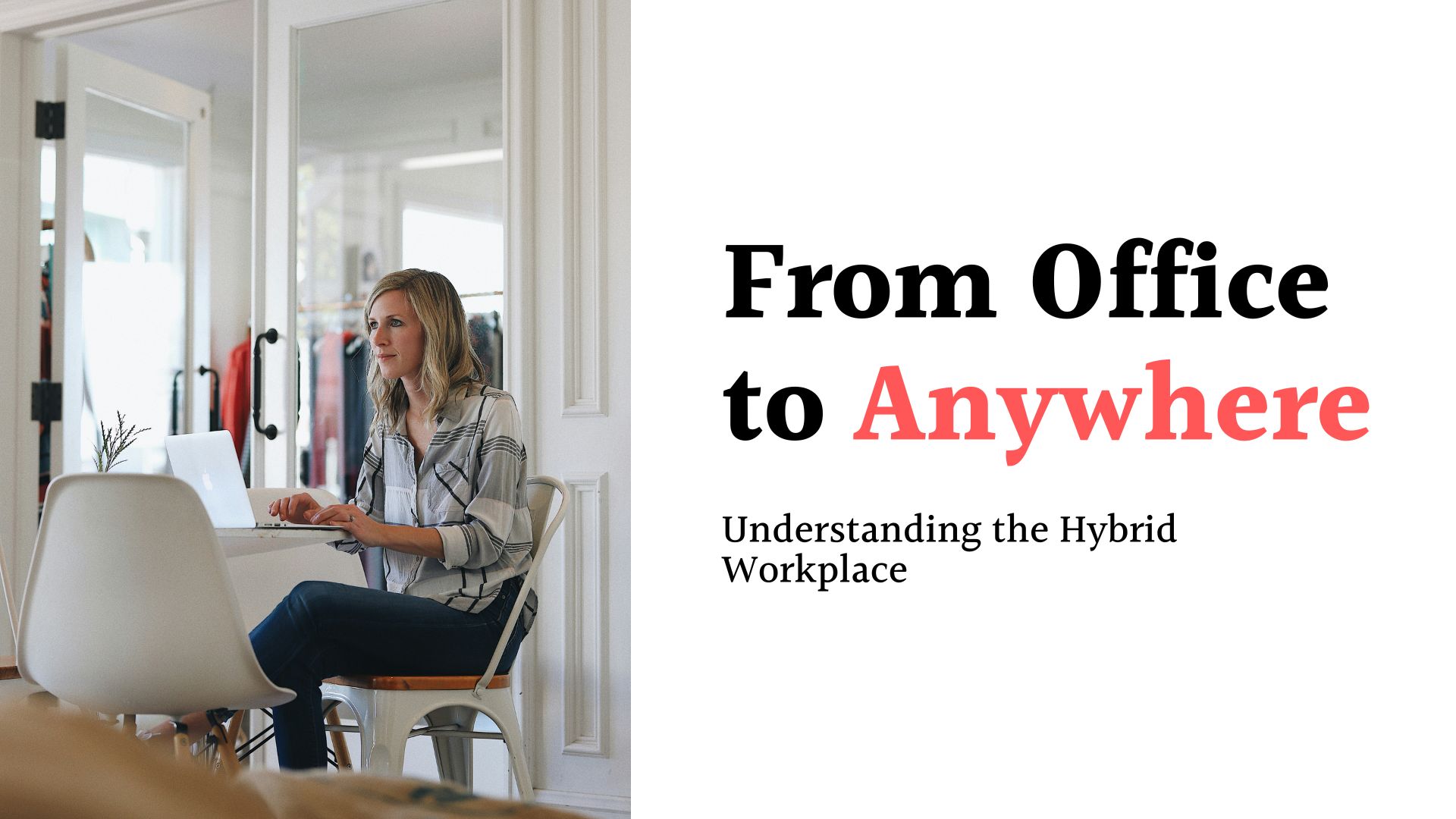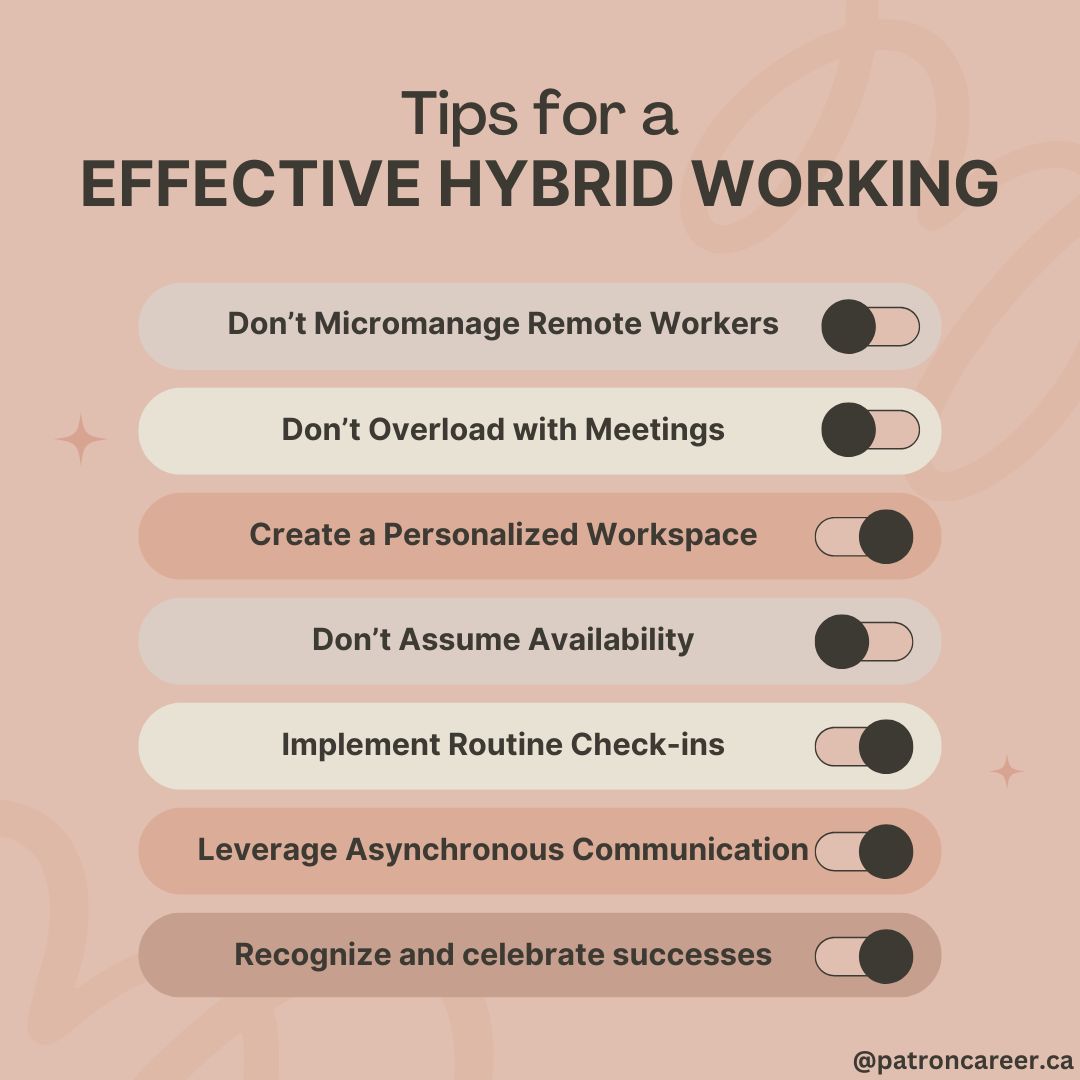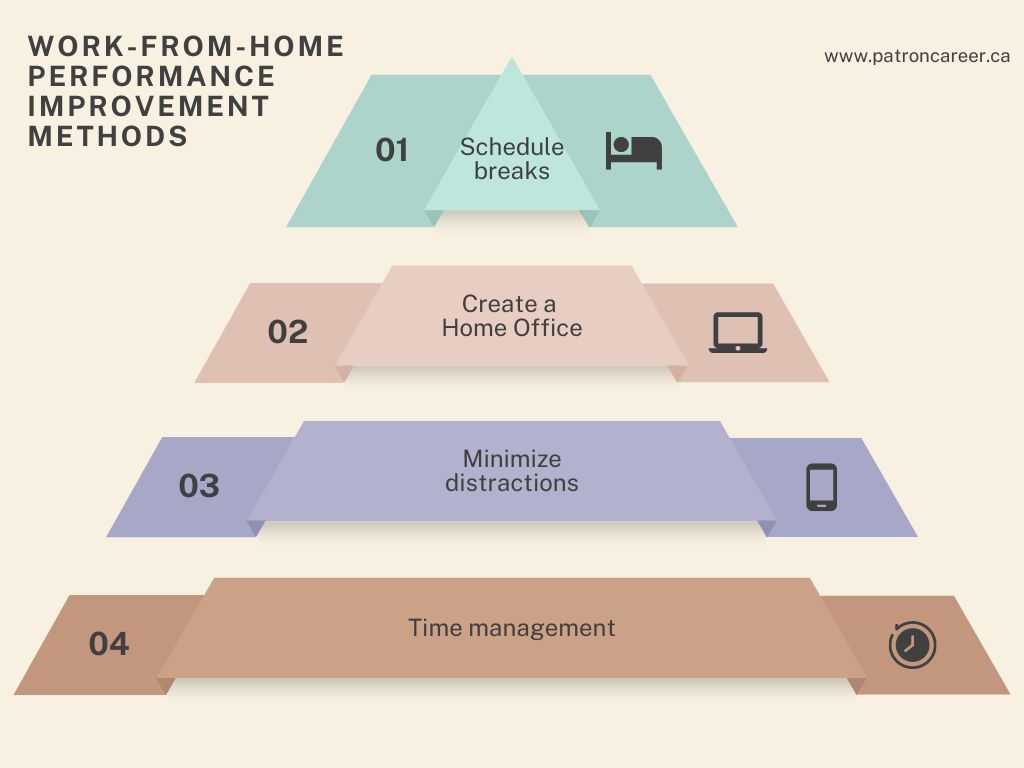
Time Management for Job Seekers
9 July, 2024
Patron Career Staffing firmly believes in adopting a tailored approach to meet temporary and permanent recruitment needs. We safeguard the interest of our clients by finding such workers who are knowledgeable and reliable.
About UsNeed help? Make a Call
32 Dundas Street East Unit A, L5A1W2

2024 and beyond is all about embracing the future of work, the apparently new normal that is hybrid work arrangements. A paradigm shift mainly brought by the pandemic, companies worldwide have adopted the hybrid model to gain significant momentum regarding office attendance, improved work-life balance, higher productivity and engagement . It has become a preferred choice of employers to combine the energy of an on-site workforce with the flexibility of remote work. According to Statistics Canada, the number of workers shifting to hybrid arrangements has enormously tripled from a 3.6 percent rate in January 2022 to 11.7 percent in November 2023.
It is safe to say that the most appealing work scenario for today’s workforce is hybrid work but to implement a hybrid work policy is no cakewalk. That’s where we come in. Keep reading our comprehensive guide to all things hybrid where we make hybrid accessible and understandable for all. Are you ready to step into the new era of work flexibility? Come on aboard.
The Propelling Shift from Traditional to Post-Pandemic Hybrid Work Ecosystem
Looking back, organizations were slowly but surely transitioning into ‘flexible working’. Then the pandemic happened and a new era of office culture dawned upon us. With its promising solutions to unlock a happier, healthier and more productive workforce, employers became inclined to bridge the gap between remote and in-office work. A 70 percent of Canadians between the ages of 20 and 24 are preferring hybrid work, a University of Waterloo study notes. Hybrid work arrangements are also a topmost choice for parents with young offspring reports Statistics Canada. This proves that hybrid work is here to stay and that people are content working hybrid.
Check out our All-in-One Handbook for Remote Employees.
What is a Hybrid Workplace?
This is a working model which is a blend of remote and office work where employees may choose to work from home full-time, the office or other locations depending upon their role and the company's remote work policies. Again, there is no broad-brush approach when it comes to working hybrid, instead, choices are made based on the goals, company culture and employee preferences. It means companies may adopt one of many models under hybrid work arrangements suited to the needs and objectives of the company and its employees. For example:
Split-Week Model
A split-week hybrid strategy allows employees to alternate between remote and office work on specific weekdays such as working from home on even days and from the office on odd days of the week.
Shift Work Model
A hybrid approach dividing teams into shifts to lessen bustling office premises at given times. This helps maintain social distancing or adhere to health guidelines. One team may be allocated a morning shift whereas another an afternoon shift or both may be given alternate days to minimize overlap.
At-Will Model
This is a preference-based hybrid strategy where employees have the freedom to choose their preferred work location. This model accelerates employee autonomy and satisfaction because how they spend their working days is up to them.
Fixed-Day Model
A set-day hybrid strategy if applied, requires all employees to show up at the office on designated days of the week. The work schedule is set by the employer and employees are expected to follow that approach rigorously. A marketing firm may require its workforce to be at the office on Thursdays and Fridays, and on other days, they can work from home.
Role-Based Model
Certain jobs reckon that employees having face-to-face interactions with clients or employing the use of specialized equipment and machinery will have more office days than remote days. Some jobs may only require a laptop and internet access to complete tasks and thus can be performed remotely. This is what a role-based hybrid model is, meaning that the unique needs of each role are assessed to consider remote or in-office work for the employee.
Read: The Rising Trend of Job Hopping in the Canadian Employment Realm
What Makes a Hybrid Arrangement Work?
Employees have got a taste of hybrid working since the pandemic and are making it a top choice for their job endeavours. Let's understand the core attributes of hybrid work arrangements:
1. Flexible Work Schedules: with hybrid work popularized, employees enjoy the option for remote or in-office work allowing them to maintain a better work-life balance.
2. Technology Integration: with the advent of remote work, the hassle of a robust technological infrastructure has also popped up. Employees have to ensure the right technology is in place-reliable internet connectivity, project management software and secure communication portals.
3. Focus on Results Over Hours: employee performance is measured by output and not the hours spent in the office chair.
4. Grants Employee Autonomy: hybrid workplaces configure greater autonomy as employees choose their working location and environment. It enhances trust, and accountability and motivates employees to deliver their best regardless of where they work.

The Upsides of Hybrid Work Arrangements
1. Better Productivity: employees can choose to work when and where they feel more productive.
2. Cost Savings: this model promotes sustainability by slashing the office footprint.
3. Access to a Wider Talent Pool: Pool: hybrid models bring in an array of top talent and skills transcending geographical boundaries.
4. Boosts Employee Satisfaction: given the greater autonomy of employees, their job satisfaction highly improves.
Disadvantages of Adopting a Hybrid Model
Applying a hybrid work policy may seem fascinating, but there are some cons also that companies should take heed of:
1. Communication Gaps: hybrid may lead to remote workers feeling distant due to reduced cross-functional communications.
2. Technology Traps: hybrid work arrangements may not pay off in the absence of reliable tech infrastructure.
3. Upholding Company Culture: employers might face challenges to sustain a cohesive company culture and align goals.
4. Performance Tracking: managing worker productivity and tracking performance insights might become complex.
How Can You Make Hybrid Work? Proven Tips for Success
1. Listen To Your Employee Needs
Employers need to tap into their workforce requirements and preferences to truly understand their challenges in the workplace. While designing the hybrid model policies, take a deep dive into the aspirations, expectations and goals of employees to foster a happy and productive workforce.
Read our newsletter on how to promote happiness at work.
2. Workplace Policies and Procedures
Companies have to reexamine their existing work policies and make adjustments or they can create comprehensive policies to cover all facets of hybrid work arrangements. Employee needs are an absolute must while framing these policies.
3. Conduct Training Sessions
After the hybrid policy is enforced, take the time to hold informational training sessions for top management and the workforce. This is a chance for companies to elucidate to employees about their strategy to make hybrid work alongside answering questions they might have.
4. Build Transparent Networks
For hybrid to be a win-win for management and workforce, pay heed to deploying transparent communications of company operations and decision-making to build trust. No remote employee should feel left out owing to ill communications and loss of connectivity.
How Setting Boundaries Fuels Hybrid Roles

Throbbing hybrid workplaces rest upon the epitomes of respect for work-life balance and the well- being of employees . A critical consideration involving the art of addressing work and personal life balance reduces chances of burnout , improves productivity, and promotes the overall health of the workforce. While transitioning to hybrid work, employees need to set clear boundaries between their personal and professional lives. Whether it delineating work time, creating dedicated workspaces or devising communication etiquette, investing in building a culture of work-life balance can consistently pay off companies to build a happy and healthy workforce free from the fetters of burnout and disengagement.
We hope you enjoyed reading our informative article on mastering the hybrid work revolution, stay tuned for more eye-catching posts.
